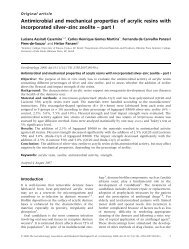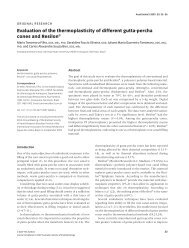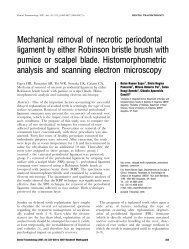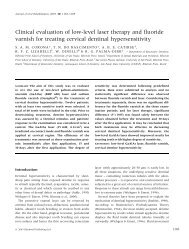Bond Strength of Self-etching Primer and Total-etch Adhesive ...
Bond Strength of Self-etching Primer and Total-etch Adhesive ...
Bond Strength of Self-etching Primer and Total-etch Adhesive ...
You also want an ePaper? Increase the reach of your titles
YUMPU automatically turns print PDFs into web optimized ePapers that Google loves.
Few articles investigate adhesive system bonding ability in<br />
primary teeth. 10-16 Due to an increasingly widespread use <strong>of</strong><br />
adhesive restorative systems, it seems relevant to assess behavior<br />
<strong>of</strong> such materials on primary tooth structure.<br />
The aim <strong>of</strong> this study was to assess the bond strength <strong>of</strong><br />
1 self-<strong><strong>etch</strong>ing</strong> <strong>and</strong> 2 total-<strong>etch</strong>, single-bottle adhesive systems<br />
to primary teeth dentin in vitro.<br />
METHODS<br />
Thirty-six sound primary canines exfoliated/extracted within<br />
a 6-month period <strong>and</strong> stored in 0.4% sodium azide solution<br />
at 4°C were selected <strong>and</strong> carefully cleaned with water/pumice<br />
slurry using dental prophylaxis cups. When necessary, roots<br />
were sectioned 2 mm below the amelocemental junction, <strong>and</strong><br />
crowns were embedded in polyester resin using polyvinyl chloride<br />
rings (2.1-cm diameter, 1.1-cm height).<br />
After resin polymerization, the rings were discarded <strong>and</strong><br />
the buccal surfaces <strong>of</strong> teeth were ground in a polishing<br />
machine (Politriz, Struers A/S, Copenhagen, DK-2610,<br />
Denmark) using water-cooled no. 320- to 400-grit silicon<br />
carbide (SiC) paper. This removed the overlying enamel <strong>and</strong><br />
exposed flat, smooth dentin surfaces.<br />
Additional grinding with no. 600-grit SiC paper was performed<br />
for 30 seconds to produce a st<strong>and</strong>ardized smear layer.<br />
To delimit the dentin bonding site, a piece <strong>of</strong> insulating tape<br />
with a 3-mm diameter central hole, created with a modified<br />
Ainsworth rubber-dam punch, was attached to the specimen<br />
surface. Limitation <strong>of</strong> the bonding site attempted to:<br />
1. define a fixed test surface so that the bond strengths recorded<br />
would be related solely to the evaluated area;<br />
2. warrant that the truncated resin composite cone would be<br />
further adhered precisely to the treated dentin surface, thus<br />
avoiding accidental adhesion to the surrounding enamel.<br />
The specimens were r<strong>and</strong>omly assigned to 3 groups <strong>of</strong> equal<br />
size (N=12), corresponding to the adhesive systems used:<br />
1. group I=Excite (EX), an ethanol-based, total-<strong>etch</strong> singlebottle<br />
bonding agent;<br />
2. group II=Single <strong>Bond</strong> (SB), an ethanol- <strong>and</strong> water-based<br />
total-<strong>etch</strong> adhesive system;<br />
3. group III=Prompt L-Pop (PLP), a self-<strong><strong>etch</strong>ing</strong> primer<br />
adhesive system.<br />
<strong>Adhesive</strong> systems for all groups were placed according<br />
to the manufacturers’ instructions. The agents were carefully<br />
applied onto the limited dentin surface with<br />
microbrush disposable brush tips. This avoided excess <strong>and</strong><br />
pooling <strong>of</strong> adhesive along the edges <strong>of</strong> the insulating tape<br />
that could compromise the distribution <strong>of</strong> tensions during<br />
the test <strong>and</strong> hence the validity <strong>of</strong> results.<br />
In group I, dentin surfaces were <strong>etch</strong>ed with a 35% phosphoric<br />
acid gel (Scotchbond Etchant, 3M/ESPE, ) for 10 seconds,<br />
rinsed thoroughly, <strong>and</strong> excess water was blotted with<br />
absorbing paper to keep the surface moist. Excite was applied<br />
to dental substrates with a light scrubbing motion for 10 seconds.<br />
Next, the remaining solvent was evaporated with a brief,<br />
mild air blast, <strong>and</strong> the bonding agent was light cured for 20<br />
seconds with a visible light curing unit using a 450 mW/cm 2<br />
output (XL 3000, 3M/ESPE).<br />
In group II, dentin sites were acid <strong>etch</strong>ed, rinsed <strong>and</strong> dried,<br />
as previously described. Then, 2 consecutive coats <strong>of</strong> Single<br />
<strong>Bond</strong> were applied to the <strong>etch</strong>ed surface, slightly thinned with<br />
a mild oil-free air stream, <strong>and</strong> light cured for 20 seconds.<br />
In group III, Prompt L-Pop components were mixed <strong>and</strong><br />
activated according to the manufacturer’s specifications, <strong>and</strong><br />
a uniform layer <strong>of</strong> the resulting mixture was applied onto dentin<br />
surfaces with a saturated microbrush, gently air thinned,<br />
left undisturbed for 15 seconds, <strong>and</strong> light cured.<br />
Once the bonding protocols were completed, specimens<br />
were individually fixed in a metallic clamping device (developed<br />
by Houston Biomaterial Research Center,) that allows<br />
the test dentin surface to remain parallel to a flat base. A splitbisected<br />
polytetrafluoroethylane jig was positioned on the<br />
tooth/resin block. This provided an inverted conical cavity<br />
with the smaller diameter coincident with the delimited bonding<br />
site (Ø 3 mm). A hybrid, light-cured composite resin (Filtek<br />
Z250, 3M/ESPE) was inserted into the jig in increments <strong>and</strong><br />
polymerized for 40 seconds each. As the cavity completely<br />
filled, the specimen was removed from the clamping device.<br />
The jig was opened <strong>and</strong> separated, leaving adhered to the<br />
delimited dentin site an inverted, truncated resin composite<br />
cone with a 6-mm diameter tapering to a 3-mm diameter<br />
<strong>and</strong> 4-mm height.<br />
After 24-hour storage in distilled water at 37°C, the coneshaped<br />
composite/polyester resin blocks were individually<br />
placed into an apparatus with an internal taper, corresponding<br />
to the resin cone’s shape. This configuration was loaded<br />
in tension to failure using a universal testing machine (Mod.<br />
MEM 2000,) at a crosshead speed <strong>of</strong> 0.5 mm/minute <strong>and</strong><br />
with 50 kgf load cell. This self-aligning system allows the<br />
forces to be applied perpendicular to the specimens’ surface.<br />
<strong>Bond</strong> strengths were recorded in kgf/cm <strong>and</strong> converted into<br />
MPA, <strong>and</strong> means were calculated. Sample distribution <strong>and</strong><br />
homogeneity were analyzed. Since a normal <strong>and</strong> homogeneous<br />
distribution was observed, data were submitted to<br />
one-way analysis <strong>of</strong> variance, using a factorial design with<br />
adhesive system as variable. Multiple comparisons were<br />
performed via Tukey test at 0.05 significance level.<br />
Fractured specimens were observed with a ×40 stereomicroscope<br />
to assess the failure modes, which were classified as<br />
adhesive, cohesive, or mixed.<br />
RESULTS<br />
Mean bond strengths <strong>and</strong> st<strong>and</strong>ard deviation to primary dentin<br />
are listed in Table 1.<br />
Table 1. <strong>Bond</strong> <strong>Strength</strong> Means (MPa) <strong>and</strong> St<strong>and</strong>ard<br />
Deviation (±) to Primary Dentin for the Experimental<br />
Groups*<br />
Groups<br />
Excite (I) Single <strong>Bond</strong> (II) Prompt L-Pop (III)<br />
12.72 (±4.89) ab 10.86 (±4.09) bc 8.66 (±2.23) c<br />
*Same letters indicate statistical similarity.<br />
132 Torres et al <strong>Bond</strong> <strong>Strength</strong> <strong>of</strong> <strong>Self</strong>-<strong><strong>etch</strong>ing</strong> <strong>Primer</strong> Journal <strong>of</strong> Dentistry for Children-71:2, 2004






